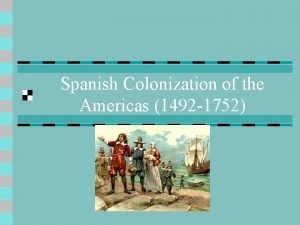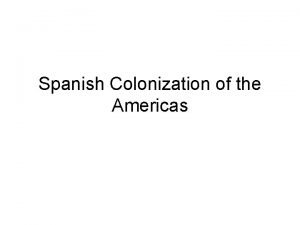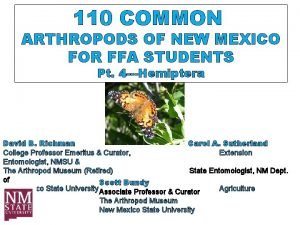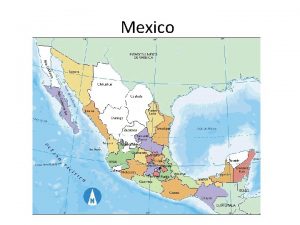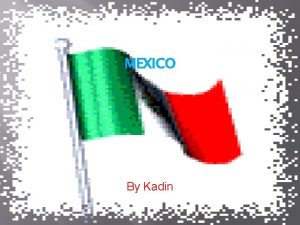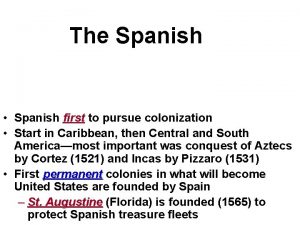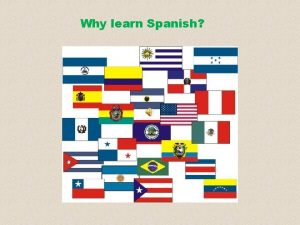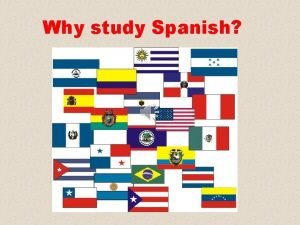Spanish Colonization of New Mexico Colonization of New












- Slides: 12

Spanish Colonization of New Mexico

Colonization of New Mexico from Mexico Colonists introduced: • Wheat, chilis, melons, etc. • Horses, cattle, sheep • Metals, glass Pueblos had: • Maize, beans, pinyon nuts • Deer, rabbits • Ceramics

Simulated Population Growth Intrinsic rate of growth among colonists insufficient to account for documented population increase Even incorporation of non. Spanish women into Spanish population insufficient In-migration must have been substantial Raises issues of distribution of land, resources to new-comers Immigrants were source of continuing Spanish cultural values, adaptations

Animals from 17 th century Pueblo and Spanish Contexts + Presence - Absence Data from C. Snow 1977; Alexander 1971; Toulouse 1949; Snow and Bowen n. d. ; Harris 1973; Chapin-Pyritz 2000.

Food Plants from 17 th Century Spanish and Pueblo Sites Pueblos generally maintained their cuisine Colonists followed mixed indigenous, Mexican, and Spanish cuisine Priests in Pueblo villages (conventos) were variable, used both strategies

Intensity of Interactions Between Colonists and Native Peoples – Ceramic Evidence Ceramics at Spanish Sites Local Pueblo Ceramics 100% 90% 80% 70% 60% Native Mexican 50% Porcelain Mexican majolica 40% Pueblo 30% Mexican Majolica 20% 10% 0% LA 591 LA 34 LA 20, 000 LA 9142 • Vast majority of ceramics produced by Pueblos • Indicates reliance on native technology/adaptation

Comparison of 17 th and 19 th Century Spanish Sites 17 th Century Sites 19 th Century Ranch Indigenous Foods Maize Beans Squash Cheno/Ams Grape Sunflower Ground cherry Purslane Pine nuts Indigenous Foods Maize Beans Ground cherry Purslane Plum Yucca Prickly pear Mexican Chili Old World Wheat Watermelon Peas Lentils Muskmelon Peach Old World Wheat Watermelon Peas Lentils Sheep/goat Horse Cow Chicken Dog Sheep/goat Horse Cow Pig Chicken Ceramics Proportions remain largely the same from 17 th through 19 th centuries (Mexican/Railroad Periods) The colonists’ adaptation to New Mexico is stable Many of the same foods were used/cultivated in both 17 th & 19 th centuries Interactions with Pueblos, as measured by ceramic exchange, remained intense

Norse Adaptation to Iceland

SASS Project’s botanical sampling looks at agricultural production and consumption between rich and poor farms: Reynistadur – wealthy farm where there is macrobotanical evidence for barley production and consumption Medalheimur – a poor farm where there is macrobotanical evidence for barley consumption

Botanical Lines of Evidence for Barley Use and Production Kernels – Indication of Consumption Pollen – Indication of Production

Assessing Production through Reconstruction of Micro-Environments at 2 Farms

Tracing “History” of Seeds Allows for Greater Interpretive Power Barley and other seeds in burnt animal dung What this reveals about Icelandic farming practices: • Suggests barley production, not just consumption • Suggests animals were grazed on fields • Indicates dung used for fuel perhaps because wood was scarce
 Spanish colonization of the americas
Spanish colonization of the americas Gold, glory, and god
Gold, glory, and god Kalumbiga meaning
Kalumbiga meaning 3 g's spanish colonization
3 g's spanish colonization Spanish 1 review packet answer key
Spanish 1 review packet answer key New mexico time line
New mexico time line Nmmip
Nmmip New mexico interlock license
New mexico interlock license New mexico brain injury resource center
New mexico brain injury resource center Acd31075
Acd31075 New mexico board of pharmacy license verification
New mexico board of pharmacy license verification New mexico ffa
New mexico ffa Cte school new mexico
Cte school new mexico
